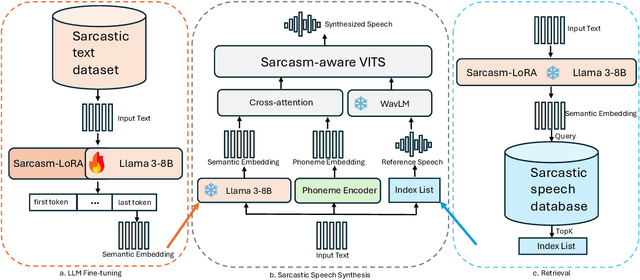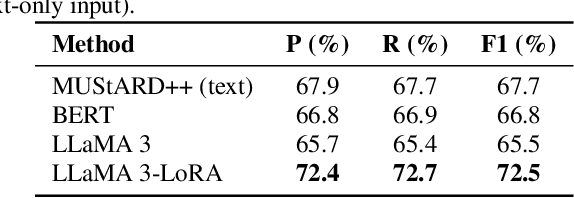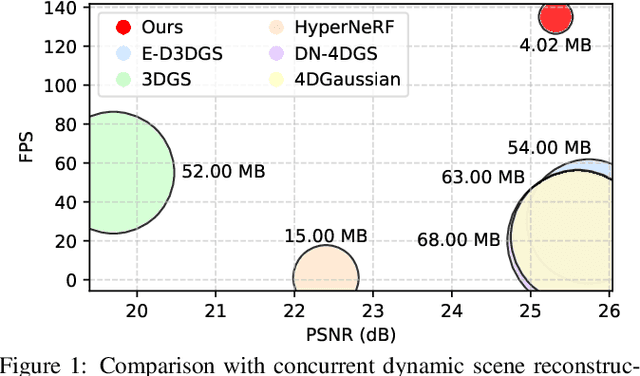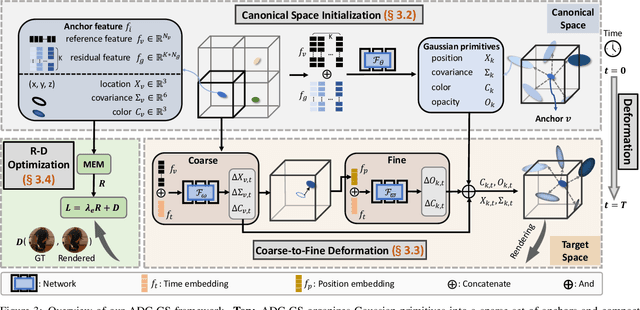Zhu Li
Lightweight 3D Gaussian Splatting Compression via Video Codec
Dec 12, 2025Abstract:Current video-based GS compression methods rely on using Parallel Linear Assignment Sorting (PLAS) to convert 3D GS into smooth 2D maps, which are computationally expensive and time-consuming, limiting the application of GS on lightweight devices. In this paper, we propose a Lightweight 3D Gaussian Splatting (GS) Compression method based on Video codec (LGSCV). First, a two-stage Morton scan is proposed to generate blockwise 2D maps that are friendly for canonical video codecs in which the coding units (CU) are square blocks. A 3D Morton scan is used to permute GS primitives, followed by a 2D Morton scan to map the ordered GS primitives to 2D maps in a blockwise style. However, although the blockwise 2D maps report close performance to the PLAS map in high-bitrate regions, they show a quality collapse at medium-to-low bitrates. Therefore, a principal component analysis (PCA) is used to reduce the dimensionality of spherical harmonics (SH), and a MiniPLAS, which is flexible and fast, is designed to permute the primitives within certain block sizes. Incorporating SH PCA and MiniPLAS leads to a significant gain in rate-distortion (RD) performance, especially at medium and low bitrates. MiniPLAS can also guide the setting of the codec CU size configuration and significantly reduce encoding time. Experimental results on the MPEG dataset demonstrate that the proposed LGSCV achieves over 20% RD gain compared with state-of-the-art methods, while reducing 2D map generation time to approximately 1 second and cutting encoding time by 50%. The code is available at https://github.com/Qi-Yangsjtu/LGSCV .
J-SGFT: Joint Spatial and Graph Fourier Domain Learning for Point Cloud Attribute Deblocking
Nov 07, 2025Abstract:Point clouds (PC) are essential for AR/VR and autonomous driving but challenge compression schemes with their size, irregular sampling, and sparsity. MPEG's Geometry-based Point Cloud Compression (GPCC) methods successfully reduce bitrate; however, they introduce significant blocky artifacts in the reconstructed point cloud. We introduce a novel multi-scale postprocessing framework that fuses graph-Fourier latent attribute representations with sparse convolutions and channel-wise attention to efficiently deblock reconstructed point clouds. Against the GPCC TMC13v14 baseline, our approach achieves BD-rate reduction of 18.81\% in the Y channel and 18.14\% in the joint YUV on the 8iVFBv2 dataset, delivering markedly improved visual fidelity with minimal overhead.
TVMC: Time-Varying Mesh Compression via Multi-Stage Anchor Mesh Generation
Oct 26, 2025Abstract:Time-varying meshes, characterized by dynamic connectivity and varying vertex counts, hold significant promise for applications such as augmented reality. However, their practical utilization remains challenging due to the substantial data volume required for high-fidelity representation. While various compression methods attempt to leverage temporal redundancy between consecutive mesh frames, most struggle with topological inconsistency and motion-induced artifacts. To address these issues, we propose Time-Varying Mesh Compression (TVMC), a novel framework built on multi-stage coarse-to-fine anchor mesh generation for inter-frame prediction. Specifically, the anchor mesh is progressively constructed in three stages: initial, coarse, and fine. The initial anchor mesh is obtained through fast topology alignment to exploit temporal coherence. A Kalman filter-based motion estimation module then generates a coarse anchor mesh by accurately compensating inter-frame motions. Subsequently, a Quadric Error Metric-based refinement step optimizes vertex positions to form a fine anchor mesh with improved geometric fidelity. Based on the refined anchor mesh, the inter-frame motions relative to the reference base mesh are encoded, while the residual displacements between the subdivided fine anchor mesh and the input mesh are adaptively quantized and compressed. This hierarchical strategy preserves consistent connectivity and high-quality surface approximation, while achieving an efficient and compact representation of dynamic geometry. Extensive experiments on standard MPEG dynamic mesh sequences demonstrate that TVMC achieves state-of-the-art compression performance. Compared to the latest V-DMC standard, it delivers a significant BD-rate gain of 10.2% ~ 16.9%, while preserving high reconstruction quality. The code is available at https://github.com/H-Huang774/TVMC.
Making Machines Sound Sarcastic: LLM-Enhanced and Retrieval-Guided Sarcastic Speech Synthesis
Oct 08, 2025


Abstract:Sarcasm is a subtle form of non-literal language that poses significant challenges for speech synthesis due to its reliance on nuanced semantic, contextual, and prosodic cues. While existing speech synthesis research has focused primarily on broad emotional categories, sarcasm remains largely unexplored. In this paper, we propose a Large Language Model (LLM)-enhanced Retrieval-Augmented framework for sarcasm-aware speech synthesis. Our approach combines (1) semantic embeddings from a LoRA-fine-tuned LLaMA 3, which capture pragmatic incongruity and discourse-level cues of sarcasm, and (2) prosodic exemplars retrieved via a Retrieval Augmented Generation (RAG) module, which provide expressive reference patterns of sarcastic delivery. Integrated within a VITS backbone, this dual conditioning enables more natural and contextually appropriate sarcastic speech. Experiments demonstrate that our method outperforms baselines in both objective measures and subjective evaluations, yielding improvements in speech naturalness, sarcastic expressivity, and downstream sarcasm detection.
DPCD: A Quality Assessment Database for Dynamic Point Clouds
May 18, 2025Abstract:Recently, the advancements in Virtual/Augmented Reality (VR/AR) have driven the demand for Dynamic Point Clouds (DPC). Unlike static point clouds, DPCs are capable of capturing temporal changes within objects or scenes, offering a more accurate simulation of the real world. While significant progress has been made in the quality assessment research of static point cloud, little study has been done on Dynamic Point Cloud Quality Assessment (DPCQA), which hinders the development of quality-oriented applications, such as interframe compression and transmission in practical scenarios. In this paper, we introduce a large-scale DPCQA database, named DPCD, which includes 15 reference DPCs and 525 distorted DPCs from seven types of lossy compression and noise distortion. By rendering these samples to Processed Video Sequences (PVS), a comprehensive subjective experiment is conducted to obtain Mean Opinion Scores (MOS) from 21 viewers for analysis. The characteristic of contents, impact of various distortions, and accuracy of MOSs are presented to validate the heterogeneity and reliability of the proposed database. Furthermore, we evaluate the performance of several objective metrics on DPCD. The experiment results show that DPCQA is more challenge than that of static point cloud. The DPCD, which serves as a catalyst for new research endeavors on DPCQA, is publicly available at https://huggingface.co/datasets/Olivialyt/DPCD.
Textured mesh Quality Assessment using Geometry and Color Field Similarity
May 16, 2025Abstract:Textured mesh quality assessment (TMQA) is critical for various 3D mesh applications. However, existing TMQA methods often struggle to provide accurate and robust evaluations. Motivated by the effectiveness of fields in representing both 3D geometry and color information, we propose a novel point-based TMQA method called field mesh quality metric (FMQM). FMQM utilizes signed distance fields and a newly proposed color field named nearest surface point color field to realize effective mesh feature description. Four features related to visual perception are extracted from the geometry and color fields: geometry similarity, geometry gradient similarity, space color distribution similarity, and space color gradient similarity. Experimental results on three benchmark datasets demonstrate that FMQM outperforms state-of-the-art (SOTA) TMQA metrics. Furthermore, FMQM exhibits low computational complexity, making it a practical and efficient solution for real-world applications in 3D graphics and visualization. Our code is publicly available at: https://github.com/yyyykf/FMQM.
ADC-GS: Anchor-Driven Deformable and Compressed Gaussian Splatting for Dynamic Scene Reconstruction
May 13, 2025



Abstract:Existing 4D Gaussian Splatting methods rely on per-Gaussian deformation from a canonical space to target frames, which overlooks redundancy among adjacent Gaussian primitives and results in suboptimal performance. To address this limitation, we propose Anchor-Driven Deformable and Compressed Gaussian Splatting (ADC-GS), a compact and efficient representation for dynamic scene reconstruction. Specifically, ADC-GS organizes Gaussian primitives into an anchor-based structure within the canonical space, enhanced by a temporal significance-based anchor refinement strategy. To reduce deformation redundancy, ADC-GS introduces a hierarchical coarse-to-fine pipeline that captures motions at varying granularities. Moreover, a rate-distortion optimization is adopted to achieve an optimal balance between bitrate consumption and representation fidelity. Experimental results demonstrate that ADC-GS outperforms the per-Gaussian deformation approaches in rendering speed by 300%-800% while achieving state-of-the-art storage efficiency without compromising rendering quality. The code is released at https://github.com/H-Huang774/ADC-GS.git.
HybridGS: High-Efficiency Gaussian Splatting Data Compression using Dual-Channel Sparse Representation and Point Cloud Encoder
May 03, 2025



Abstract:Most existing 3D Gaussian Splatting (3DGS) compression schemes focus on producing compact 3DGS representation via implicit data embedding. They have long coding times and highly customized data format, making it difficult for widespread deployment. This paper presents a new 3DGS compression framework called HybridGS, which takes advantage of both compact generation and standardized point cloud data encoding. HybridGS first generates compact and explicit 3DGS data. A dual-channel sparse representation is introduced to supervise the primitive position and feature bit depth. It then utilizes a canonical point cloud encoder to perform further data compression and form standard output bitstreams. A simple and effective rate control scheme is proposed to pivot the interpretable data compression scheme. At the current stage, HybridGS does not include any modules aimed at improving 3DGS quality during generation. But experiment results show that it still provides comparable reconstruction performance against state-of-the-art methods, with evidently higher encoding and decoding speed. The code is publicly available at https://github.com/Qi-Yangsjtu/HybridGS.
CompGS++: Compressed Gaussian Splatting for Static and Dynamic Scene Representation
Apr 17, 2025



Abstract:Gaussian splatting demonstrates proficiency for 3D scene modeling but suffers from substantial data volume due to inherent primitive redundancy. To enable future photorealistic 3D immersive visual communication applications, significant compression is essential for transmission over the existing Internet infrastructure. Hence, we propose Compressed Gaussian Splatting (CompGS++), a novel framework that leverages compact Gaussian primitives to achieve accurate 3D modeling with substantial size reduction for both static and dynamic scenes. Our design is based on the principle of eliminating redundancy both between and within primitives. Specifically, we develop a comprehensive prediction paradigm to address inter-primitive redundancy through spatial and temporal primitive prediction modules. The spatial primitive prediction module establishes predictive relationships for scene primitives and enables most primitives to be encoded as compact residuals, substantially reducing the spatial redundancy. We further devise a temporal primitive prediction module to handle dynamic scenes, which exploits primitive correlations across timestamps to effectively reduce temporal redundancy. Moreover, we devise a rate-constrained optimization module that jointly minimizes reconstruction error and rate consumption. This module effectively eliminates parameter redundancy within primitives and enhances the overall compactness of scene representations. Comprehensive evaluations across multiple benchmark datasets demonstrate that CompGS++ significantly outperforms existing methods, achieving superior compression performance while preserving accurate scene modeling. Our implementation will be made publicly available on GitHub to facilitate further research.
Light4GS: Lightweight Compact 4D Gaussian Splatting Generation via Context Model
Mar 18, 2025



Abstract:3D Gaussian Splatting (3DGS) has emerged as an efficient and high-fidelity paradigm for novel view synthesis. To adapt 3DGS for dynamic content, deformable 3DGS incorporates temporally deformable primitives with learnable latent embeddings to capture complex motions. Despite its impressive performance, the high-dimensional embeddings and vast number of primitives lead to substantial storage requirements. In this paper, we introduce a \textbf{Light}weight \textbf{4}D\textbf{GS} framework, called Light4GS, that employs significance pruning with a deep context model to provide a lightweight storage-efficient dynamic 3DGS representation. The proposed Light4GS is based on 4DGS that is a typical representation of deformable 3DGS. Specifically, our framework is built upon two core components: (1) a spatio-temporal significance pruning strategy that eliminates over 64\% of the deformable primitives, followed by an entropy-constrained spherical harmonics compression applied to the remainder; and (2) a deep context model that integrates intra- and inter-prediction with hyperprior into a coarse-to-fine context structure to enable efficient multiscale latent embedding compression. Our approach achieves over 120x compression and increases rendering FPS up to 20\% compared to the baseline 4DGS, and also superior to frame-wise state-of-the-art 3DGS compression methods, revealing the effectiveness of our Light4GS in terms of both intra- and inter-prediction methods without sacrificing rendering quality.
 Add to Chrome
Add to Chrome Add to Firefox
Add to Firefox Add to Edge
Add to Edge